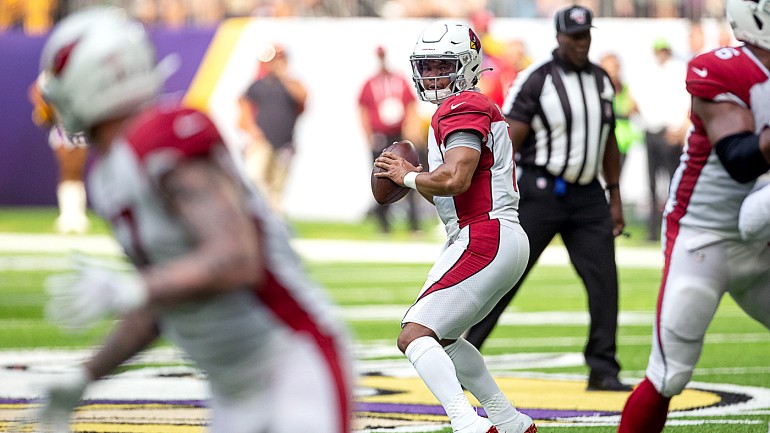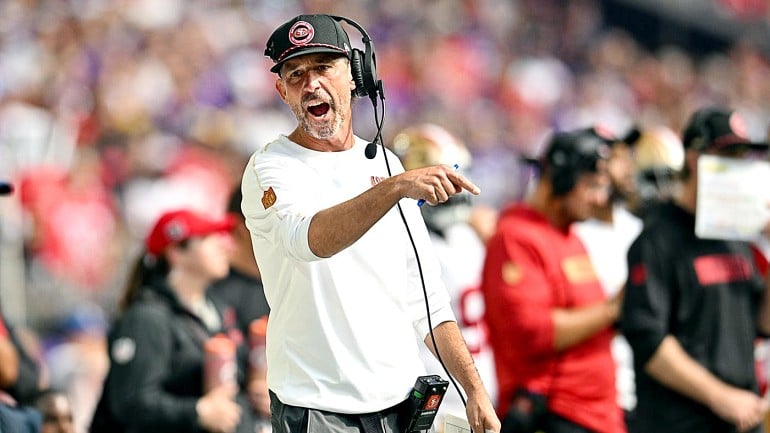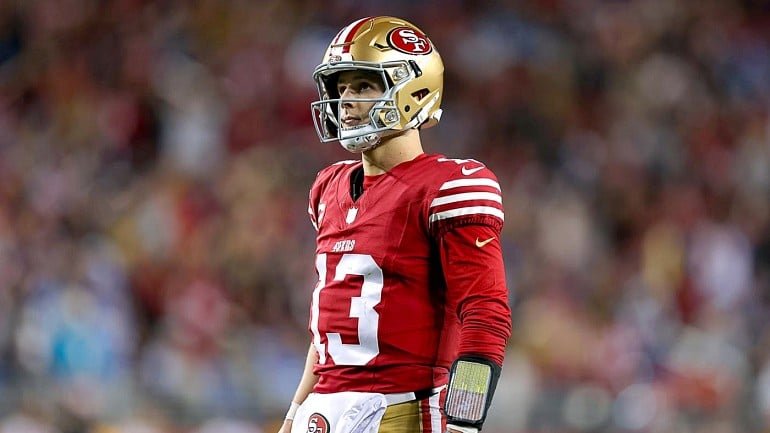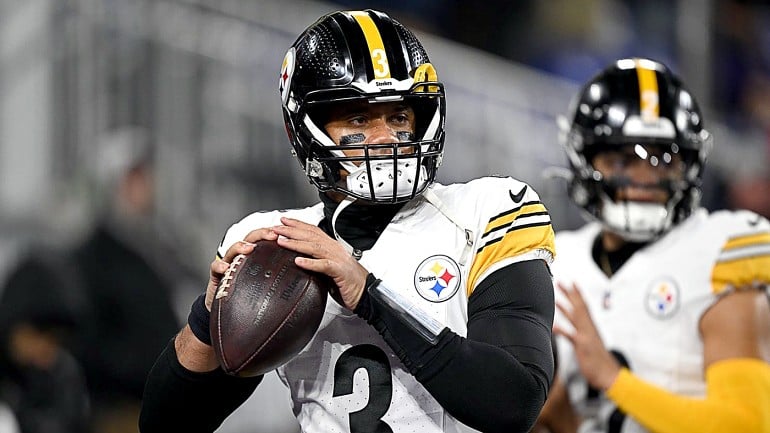In part one of this series, we looked at the Air Raid's history and its running game concepts. Today we'll take a look at the passing game concepts.
A lot of the passing game concepts in the Air Raid might look familiar to 49ers fans and football fans in general. All 32 teams run some variations of the concepts we'll see below, including the 49ers. The best coaches over the course of the last several decades in football have evolved and adapted the ideas of others into their own versions of whichever offense it is they run. The Air Raid and West Coast offenses in particular look very similar in a variety of different concepts.

Some of those concepts might look familiar to 49ers fans. Shanahan runs them. Different schemes have been borrowing from each other since the dawn of football. The only difference between Shanahan's concepts and Kingsbury's might be the play nomenclature and the personnel groupings used, but their goals are the same: work the entire field.
The nature of the Air Raid offense is that it is a true spread-the-field and attack all levels of the defense from the short, middle, and deep areas to the seams to the sidelines. The defense must be able to cover it all. The Cardinals are also predominantly using 10 personnel (one running back, no tight ends), 11 personnel (one running back, one tight end), and 12 personnel (one running back, two tight ends) this preseason, groupings conducive to a multi-level passing attack.
Speaking to Charles McDonald of SB Nation for a recent article however, Sonny Dykes stresses that the offense Kingsbury will be running won't be a traditional Air Raid:
"If you look at Kliff and the plays that he's emphasized, you're not going to see a true air raid. You're not going to see a ton of mesh. You're not going to see a lot of the old NCAA routes. Certain things that the air raid is built on are plays that Kliff has transitioned away from over the past couple years. He's transitioned into more of the creative things that are happening in the NFL and college football, as well."
Kingsbury didn't run a traditional offense at Texas Tech either, and stated this offseason that his offense would actually resemble more of what quarterback Kyler Murray was used to at Oklahoma, itself a version of the pass-happy Air Raid. At Oklahoma, head coach Lincoln Riley used more two back sets than Kingsbury did at Texas Tech. But what does the passing game entail?
The passing game includes horizontal stretches, vertical stretches, and multiple high-low reads to put constant pressure on a defense and keep it in conflict.
Horizontal stretch pass plays
All curls
The simplest passing game concept in the Air Raid lexicon is the "all curl" concept or "curl-flat."
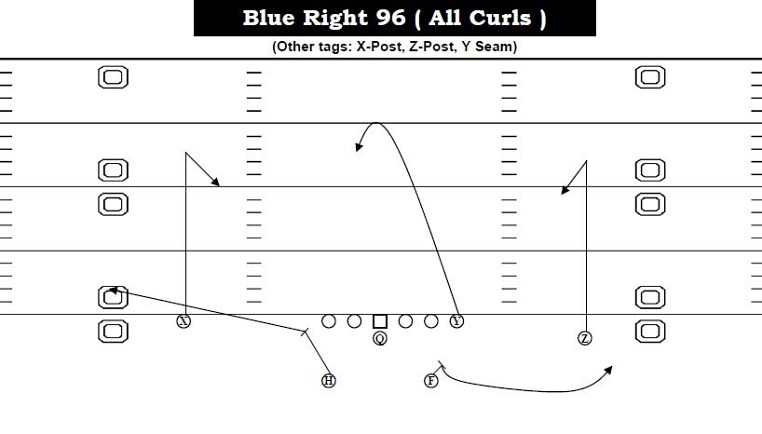
All curls is a horizontal stretch passing play that once executed, has all receivers turning to face the quarterback to look for the pass. Where the pass goes is largely dictated by the defense but this can best take advantage of a 3-deep 4-under zone.
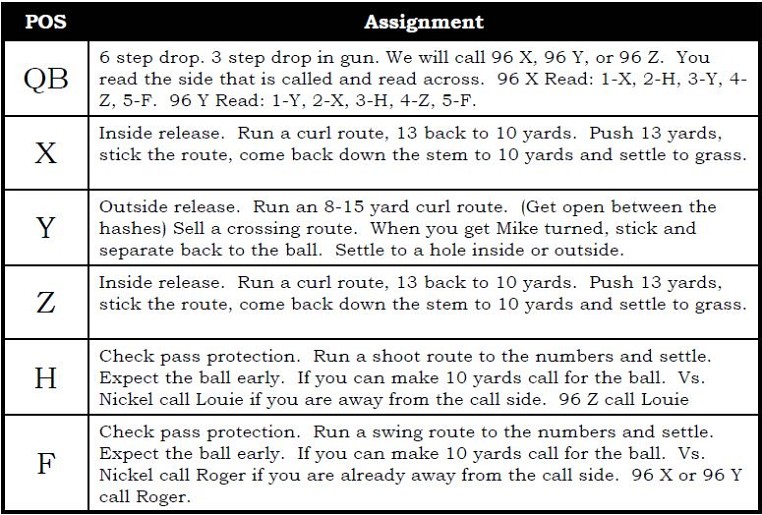
It's simple, all the receivers in the formation run curls, either at six yards in the quick passing game, or 10-13 yards in a deeper passing game. Curls can really be run at any depth depending on the down and distance as receivers are typically coached to get to the sticks to get a first down.
One variation is to run the play with five-yard curls from a 3x2 formation. Here against the Arizona State Sun Devils, Patrick Mahomes reads the pre-snap defense and sees two defenders sitting at curl depth already. The inside slot is uncovered and has space to work with so Mahomes goes to him immediately before the safety can come downhill to challenge the pass.
Another variation from Oklahoma's offense is to run the curls deeper or to the sticks depending on the down and distance. On this variation, the right side of the offense all runs deep curl routes while quarterback Kyler Murray works the left side curl/flat combination. The flat route stretches the overhand defender away from the curl and opens the throwing lane. If the defender doesn't widen with the flat, the quarterback can check it down to the running back in the flat.
Vertical stretch pass plays
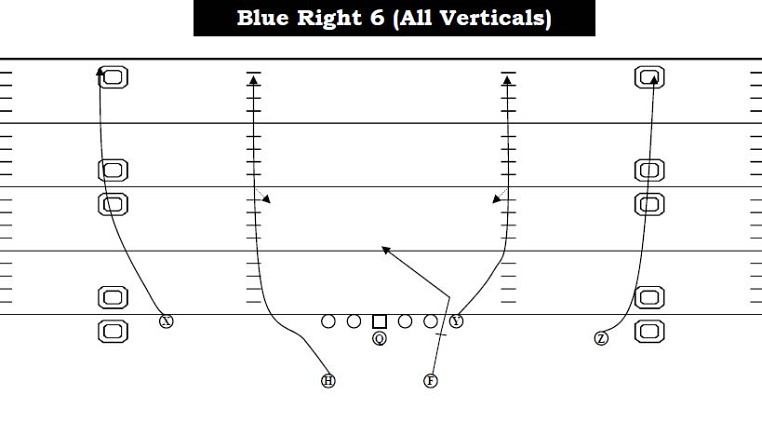
The most common vertical stretch pass play is the basic four verticals passing concept. It's a straightforward simple play, all receivers run go routes down field.
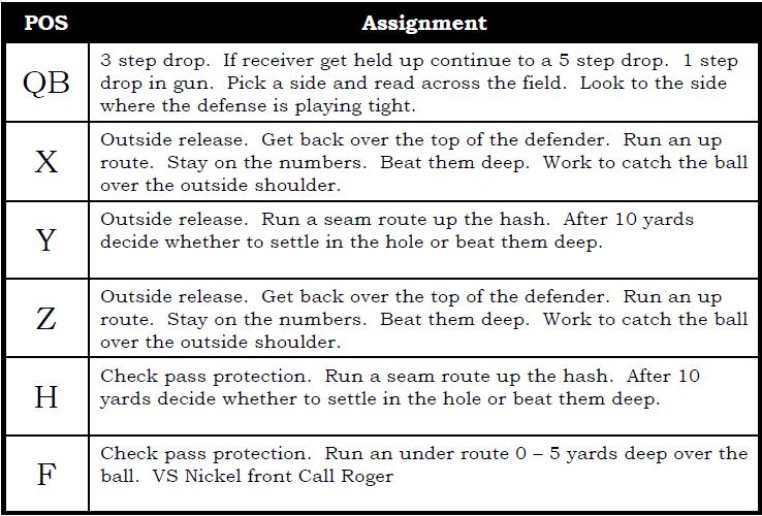
There are nuances to the play though. Any receiver has the ability to stop his deep route at 10 yards and turn to look for a pass. Doing this is dependent on what the defense is doing. If the receiver cannot run past the safety or corner by 10 yards, his read becomes a 10-yard stop route, turn, and look for the pass.
The play was made popular by Texas Tech under head coach Mike Leach in the late 2000s in a game that featured two former 49ers, TT wide receiver Michael Crabtree and UT quarterback Colt McCoy, as well as Earl Thomas, and numerous other NFL players. Tech was trailing by one point with eight seconds left when quarterback Graham Herrell found Crabtree down the sideline running a vertical route. The back shoulder throw allowed Crabtree some space to catch and elude defenders before sprinting to the end zone for the game-winning score. Notice the seam read by the slot receiver next to Crabtree on the right.
When four verticals is run out of trips 3x1, the inside slot receivers have to angle up and over the field to occupy the safeties and create space for the quarterback to throw the ball.
The secondary shows five across but actually rotates into Tampa 2 robber post snap, leaving the safety to the field side alone with two verticals down the hash and sideline. Mahomes could have hit either vertical but chose the outside vertical as the safety has his back turned to it. Touchdown.
Shallow sting
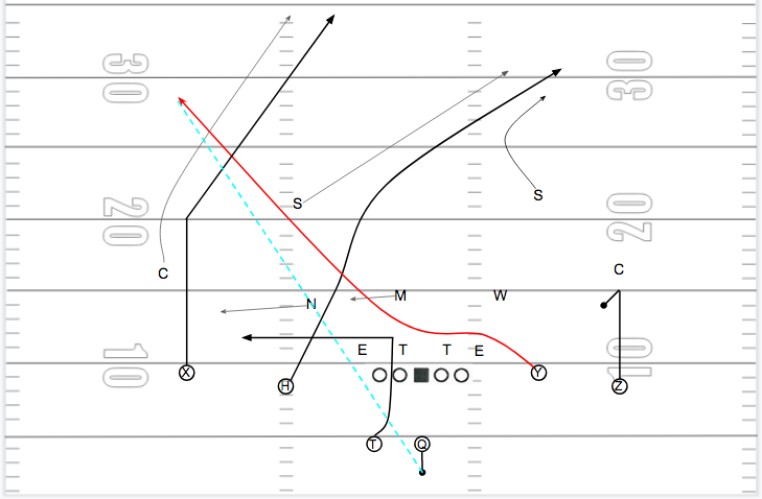
Source: Noah Riley's Breaking Down Lincoln Riley's 2018 Oklahoma Offense
Another pure vertical stretch we could see from the Cardinals is a concept run at Oklahoma called the "shallow sting."
To the two receiver side, the receivers are running double posts while the slot receiver coming from the opposite side starts out by running a shallow cross. The boundary safety would normally be responsible for #2 in the slot in quarters coverage, which the defense is in but passes him off when he doesn't run vertical.
The slot breaks across and then angles up to the end zone and no one covers him. The safeties and field corner are occupied with the double posts and the linebackers are occupied with the flat. The end result is that the slot receiver is left wide open for a touchdown pass from Murray.
High-low stretches/reads
Perhaps the core concepts of Kingsbury's offense though will come in the form of high-low stretches and reads like smash, Y-cross, mesh, HOSS, slot/fade, and snag.
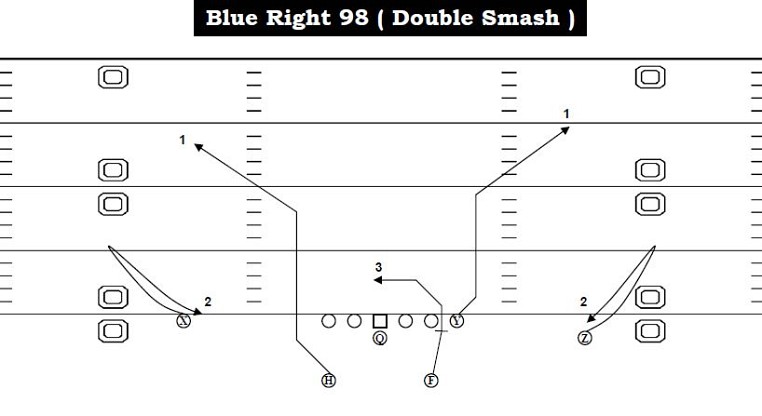
Smash should look familiar to 49ers fans as it was a staple pass play of the Harbaugh-era 49ers. Smash is a high to low concept where the slot receiver runs a corner route and the outside receiver runs a smash route at 5 yards (curl, hook, search route, etc.). The play is a designed cover-2 beater.
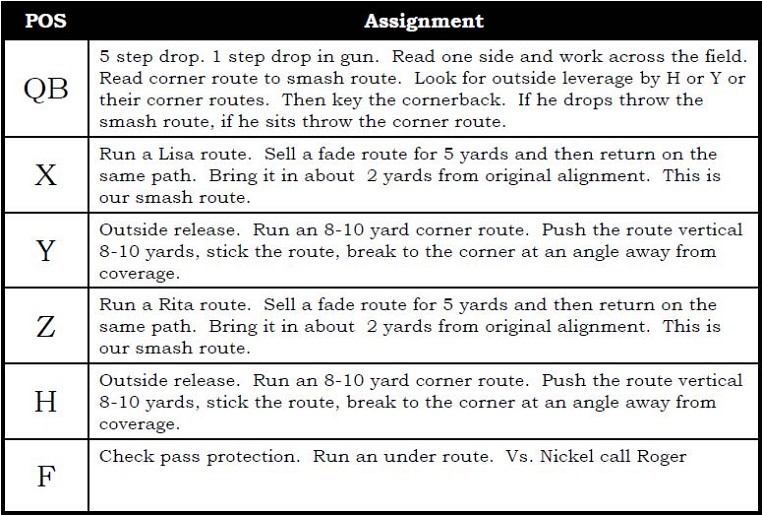
The outside receivers in the Air Raid offense run something called a "Rita/Lisa" route where they angle out like they're running a fade but cut back down the same path. They can also run a quick 1-step stop or hitch as well.
On this play against Arizona State, Texas Tech is running "98 double smash" where the outside receivers run short five-yard in routes. The safety sits on the corner route of the top on the boundary side of the formation so Mahomes comes off it and hits the quick in route from the outside receiver for a touchdown.
Another variation of smash is "smash y-cross."
Smash y-cross is run out of a 3x2 empty formation. The inside slot on the three receiver side runs the y-cross while the rest of the slots and outside receivers run smash. The robber safety jumps the y-cross and leaves the corner route open 1-on-1 against the field safety. Mahomes drops a nice pass over the top of the safety and leads his receiver up field for the catch.
95 Y-cross
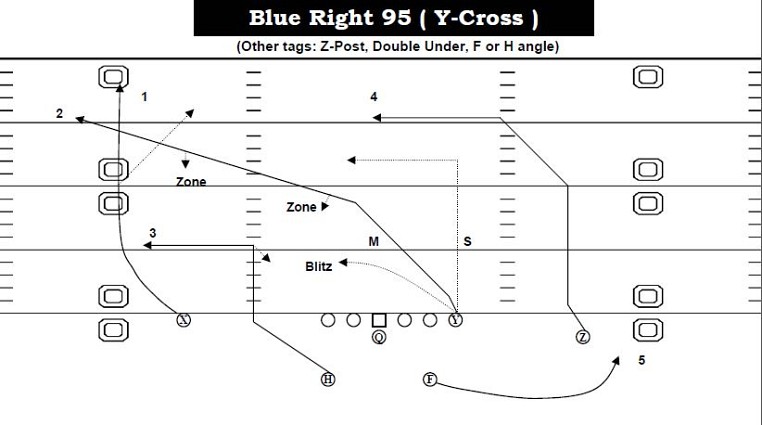
The Y-cross is as much of a staple of the Air Raid offense as "2 jet flanker drive" is to the West Coast Offense. It was originally installed before four verticals and was the premier deep passing game play when it was first run at BYU under LaVell Edwards.
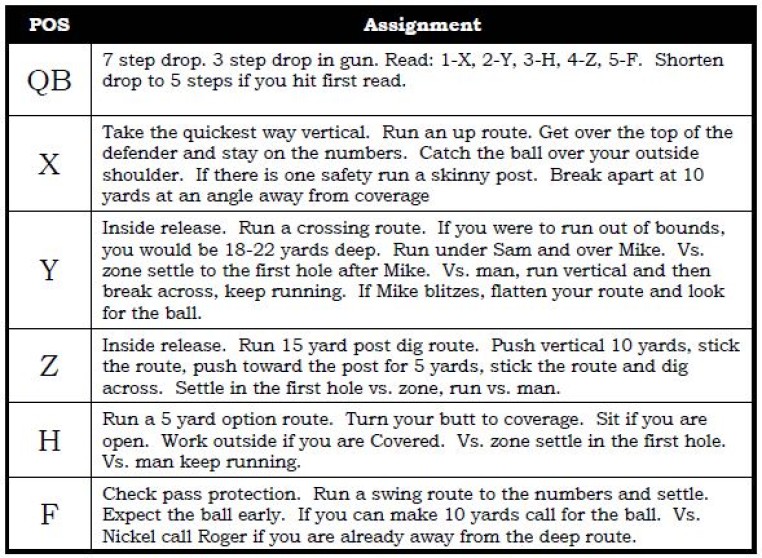
The Y in Y-cross should run a crossing route with an inside release 18-22 yards deep. The original play could also be a weak flood play and there are multiple ways to run the play, but the basic premise is the Y needs to get deep across the field while the back side receiver clear out or runs a deep post and the slot hits the flat.
Here Kingsbury uses a go route/bubble screen to the flat concept to occupy the overhang defenders as the receiver to the boundary runs the cross. The defenders are preoccupied with the go route and fake bubble screen, opening the middle of the field for the Y-cross. Mahomes pumps the screen before coming back to the crosser for the touchdown.
Orbit Y-Cross
One way to spice things up on this concept is to run the play with an opposite orbit motion. The orbit motion holds the second level defenders in place with their eyes in the back field as the y-cross crosses the field behind them. Murray delivers the pass in front of the deep middle safety.
Counter GT fake with Y-cross
To build an effective play action pass in today's modern football, the best offenses are utilizing the linemen's run blocking assignments to really sell run. It's one reason the 49ers play action game is one of the league's best, because Shanahan sells it with the action of the linemen on the outside zone. Kingsbury will have to do the same and one way to do it is to use the blocking of your base run game: the counter.
The fake GT counter with Y-cross behind it is one way. The second level defenders bite hard on the run action as the receiver slips behind them and across the field for a nice gain.
Fake Y-cross stem seam
Another good tendency breaker is the fake y-cross stem seam. On this play, Murray executes a run fake that holds the middle linebacker in place as the slot receiver angles in.
Now the linebacker has to have eyes on the run and a potential crossing route. As he looks and sees the receiver angling in toward him, the receiver cuts up the seam and runs right by him. Murray initially wants to go to the go route down the sideline but the safety climbs over the top of it so he comes back to the inside seam and hits the receiver deep in the back of the end zone for a touchdown.
Mesh
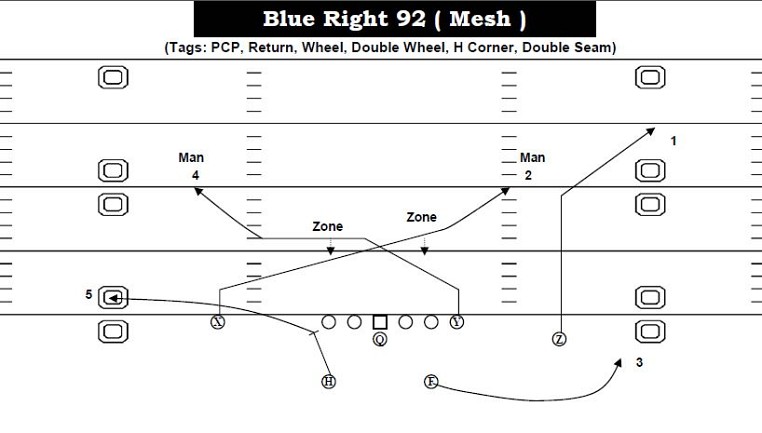
Mesh is another classic Air Raid staple characterized by shallow crossing routes underneath that form a sort of pick or rub on the defense, especially in man coverage, though it isn't illegal because the receivers aren't trying to pick a defender. According to S.C. Gwynne in The Perfect Pass, it was originally the play that gave Hal Mumme the most trouble installing, saying "He had diagrammed it, and diagrammed it again, but in spite of his efforts, he did not feel he understood it well enough to try it in a game. The timing between the quarterback and receivers was not right."
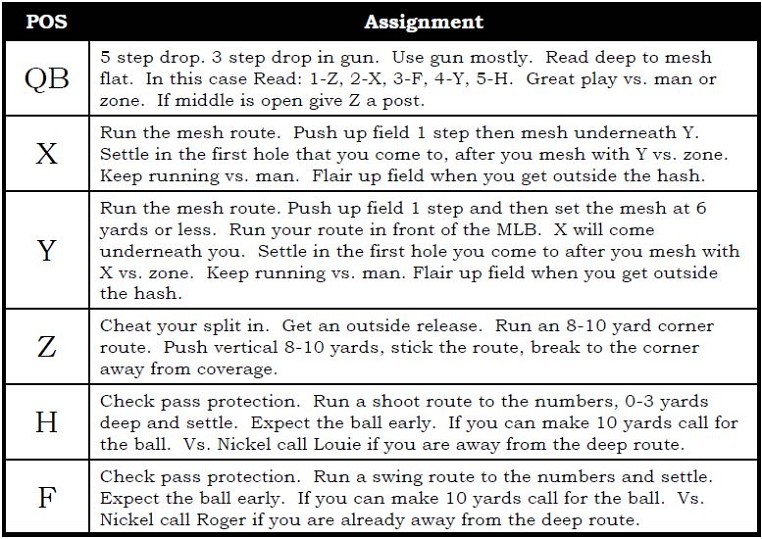
The key feature of mesh is the two receiver crossing pattern at a depth of 6 yards. They'll either settle in the zone or keep running against man. The 3rd receiver in the pattern is the intermediate receiver who can either run a post, a corner, or deep sit over the middle with a backside receiver running an out pattern.
Mesh is still run similar to its original variant but there have undoubtedly been slight variations. Here Texas Tech runs the play with the mesh crossers and a receiver who sits deep over the middle between the two. Mahomes has to scramble so the sit route takes off toward the sideline in a scramble drill as Mahomes finds the receiver for a nice gain.
Dagger Mesh
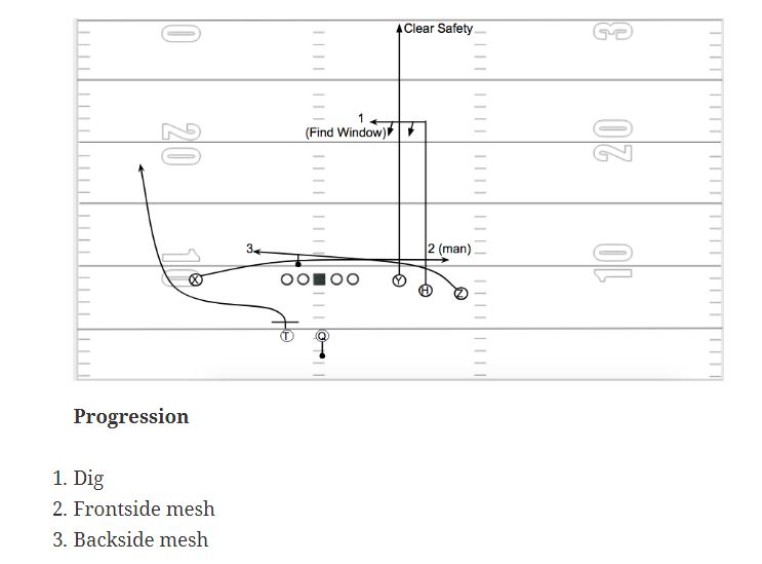
Source: Noah Riley's Breaking Down Lincoln Riley's 2018 Oklahoma Offense
A variant we could also see out of Kingsbury's offense is the "dagger mesh." Dagger mesh is just like regular mesh, but there is a dagger/seam concept built in that when combined with the shallow crossing routes, effectively stretches the defense both horizontally and vertically. Dagger/seam is an inside seam route with a deep in route behind it. The receiver can either sit in the zone or keep running across against man coverage.
Out of a 3x1 trips to the right, Oklahoma is running dagger mesh. Out of a trips bunch, we see the shallow cross and the dagger/seam routes. The underneath crossing routes occupy the attention of the Texas Tech second level defenders. The receivers pull away the defenders from the dig route just long enough to open a window that Murray can fit the pass into. The seam route pulls the safety deep and the result is that Murray finds the receiver in the open window.
Snag/Double slants (Shoot concept)
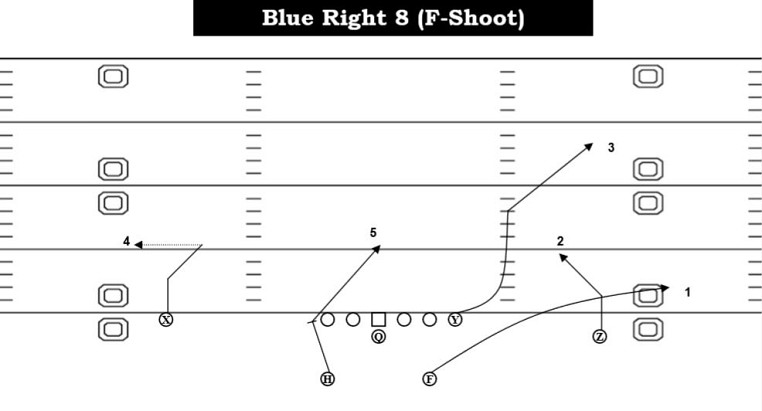
This a dual concept play that the quarterback should determine pre-snap based on the coverage. The first side is the snag concept side. Snag is a three level triangle stretch play where the inside receiver runs a corner route at 8-10 yards, the outside receiver runs a one-step slant and cuts across the formation, and the receiver out of the backfield runs out to the flat.
Oklahoma is running snag to the short side of the field. The defenders widen with the flat route and sink under the corner, briefly leaving a window for the quick slant receiver to sit in the zone and catch the pass.
On the other side of the snag concept is the double slants concept. According to Noah Riley in Breaking Down Lincoln Riley's 2018 Oklahoma offense, "the Sooners would run their double slant to the field, with the inside receiver running a 1-step slant and the outside receiver running a 3-step slant." Murray's read became the overhang defender. If the overhang widened, Murray would throw the inside slant, if the overhang ran with the inside slant, the outside slant would be open. Here the overhang defender ran with the inside slant so Murray threw behind him for a completion.
66 HOSS
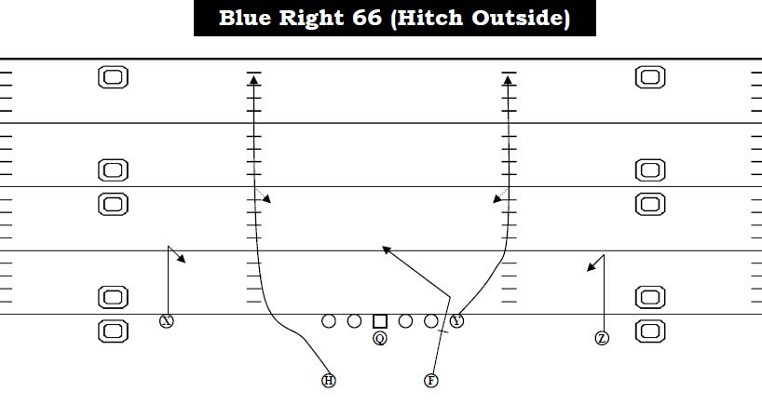
66 HOSS is another high-low read on the overhang or flat defender. HOSS stands for "hitch outside seam" for a hitch route that's run outside of a seam route run by the slot receiver.
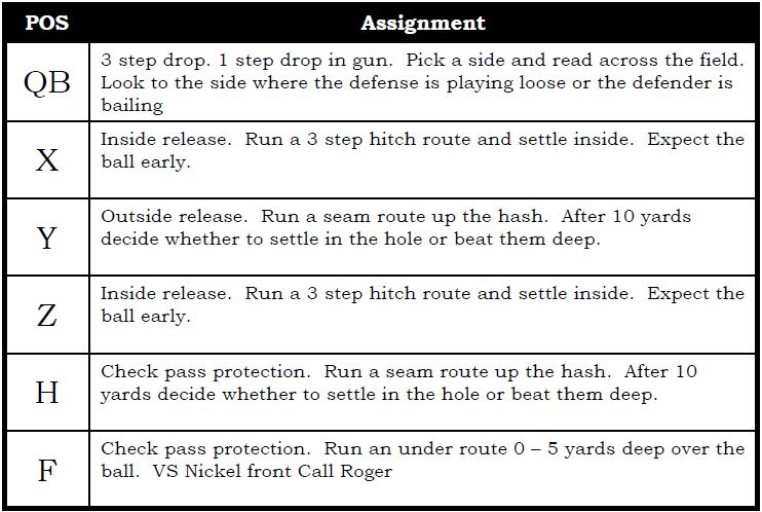
The receivers on the outside take an inside release and run hitch routes anywhere from three to five yards. The slot receivers take an inside release and run down the seam while also having a seam read and the option to stop and sit at 10 yards depending on the coverage. Against 1-high coverage, the read becomes the hitch seam combination by reading the flat defender. If the flat defender plays the vertical, throw the hitch. If the flat defender widens to the flat under the hitch, throw the seam. Against 2-high coverage, the read becomes the middle linebacker and the inside option route since it's isolated against the MIKE.
Here against FAU, Murray throws the hitch to the right as the seam is walled off underneath by the nickel/overhang defender who runs with low inside leverage with a safety over the top.
Stick slot fade
Another base concept for the Sooners and one that will likely be a big one for the Cardinals is the Y-stick slot fade concept.
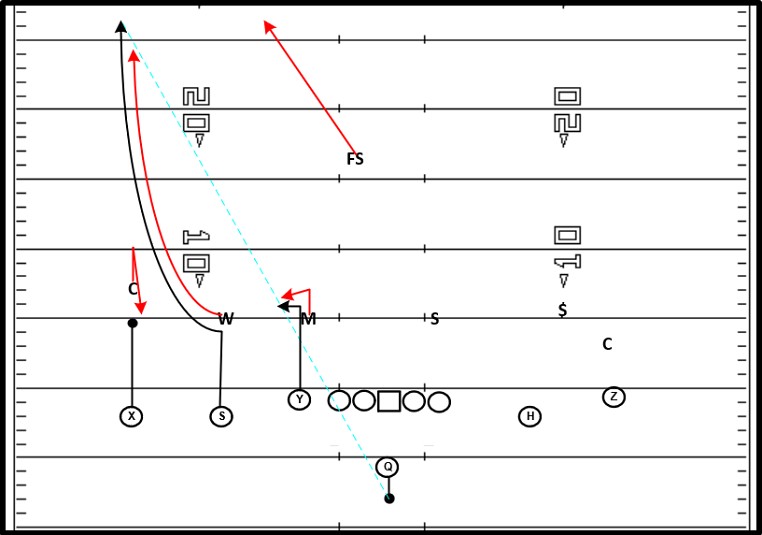
Source: Riley Kolste Football
The play is run out of a 3x1 or 3x2 trips formation with the progression going from the slot fade to the stick to the back side concept, usually some kind of slant/flat combination or short option route from the back side slot. Against man coverage, the throw almost always goes to the slot fade down the seam, especially against cover-0 or cover-1 coverages.
In this clip from 2017, Baker Mayfield finds the fade route down the seam between the hash and the numbers against a cover-0 from the TCU defense.

Another option is to hit the stick route depending on the depth and zone drop of the linebacker, usually the MIKE.
Here against FAU, Murray hits the #3 receiver on the stick route as the linebacker does not widen with the trips. The defender over the #2 has pretty good inside leverage to challenge any fade throw so the obvious decision is to throw the stick immediately, which Murray does, and keeps the chains moving.
Slot fade against 2 deep
One of the aspects of the Air Raid that make it a potentially dangerous offense is the amount of checks and reads the receivers have against certain coverages. Texas Tech is running a slot fade against a cover-2 deep zone. The slot receiver releases vertically down field but cannot run past the safety so he runs a deep out away from the coverage as the quarterback finds him along the sideline.
Play action passes
Naked boot
There are many variations of the boot pass that could show up on Sundays so we'll run through just a couple of them.
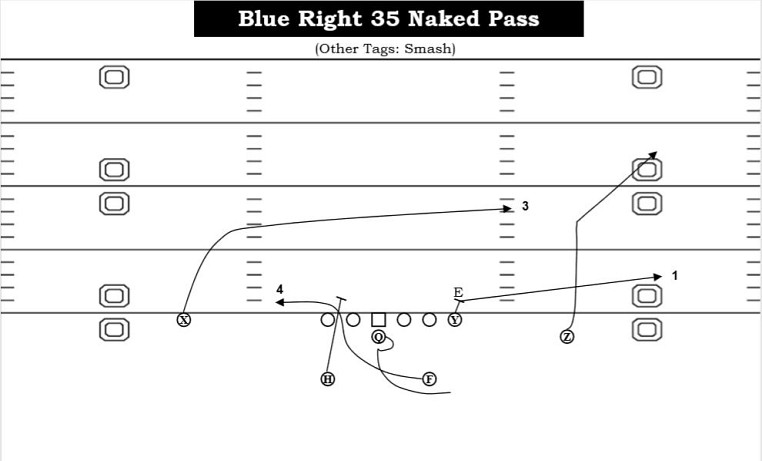
Every NFL offense runs a naked boot and the Cardinals will be no different. Above is the classic Air Raid version of the naked boot.
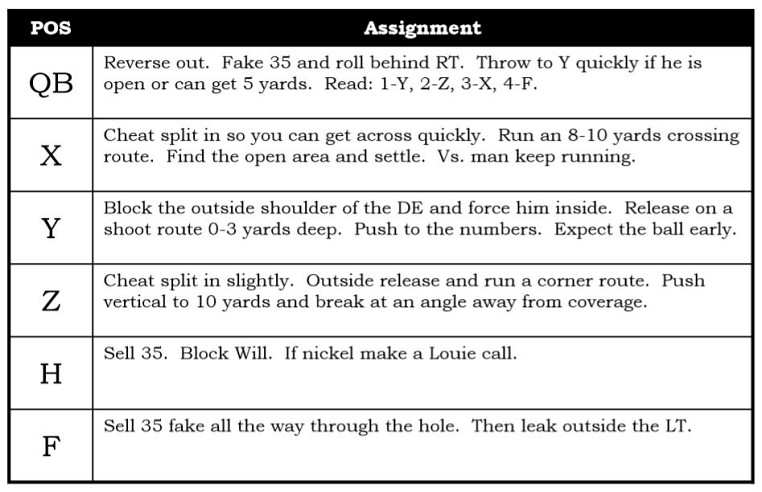
The quarterback should throw the shallow flat route right away if the receiver is open. If not, the progression goes to the deep route on the play side then to the backside crossing route.
Here, Texas Tech is running the naked boot but with the shallow crosser coming from the back side instead of out to the flat. Mahomes' rollout gets forced deeper into the backfield than the usual 5-7 yard roll-out, preventing him from hitting the crossing routes so he flings it out to the deep comeback route but the pass falls incomplete.
Boot smash
A variation that we're also likely to see is the "boot smash," which, as the name implies, is a naked bootleg pass where the front side pass concept is a smash combo with a corner and hitch route. On the hitch route, the receiver releases outside as if he were running a fade route but stops at around 6-7 yards and turns and looks for the pass from the quarterback.
On the play here, Murray rolls out to the right looking to throw the hitch. The corner doesn't sink with the corner route downfield and instead blankets the hitch route. This left the deep safety 1-on-1 with the receiver so Murray threw the deep corner and led his receiver up field for the catch and touchdown.
This passing game breakdown is not a comprehensive list of the concepts 49ers fans can expect to see out of the Cardinals but they should familiarize themselves with the concepts, identifying how they work and why they can be effective. And we didn't even cover the run-pass option or screen game concepts that we'll see this season. Nonetheless, I hope this series on the Cardinals helps the reader to better understand the schematic concepts employed by the Air Raid under Kliff Kingsbury.
For further reading on the history and schematics of the Air Raid offense:
Books
S.C. Gwynne, The Perfect Pass: American Genius and the Reinvention of Football
Noah Riley, Breaking down the 2018 Oklahoma Offense
Cody Alexander, Desert Heat: The Air Raid Invades the NFL – Pt. 1 and Desert Heat: The Air Raid Invades the NFL – Pt. 2
Chris Brown, The Air Raid Offense: History, Evolution, Weirdness – From Mumme to Leach to Franklin to Holgorsen and Beyond
Chris Brown, Texas Tech run game cut-ups
Benjamin Hoffman, The Air Raid Offense Invades an N.F.L. That It Already Conquered
Charles McDonald, Two air raid coaches tell us what we can expect from Kliff Kingsbury's offense in the NFL
Michael Lewis, Coach Leach Goes Deep, Very Deep
Video
Oklahoma All-22 cut-ups courtesy of Noah Riley
